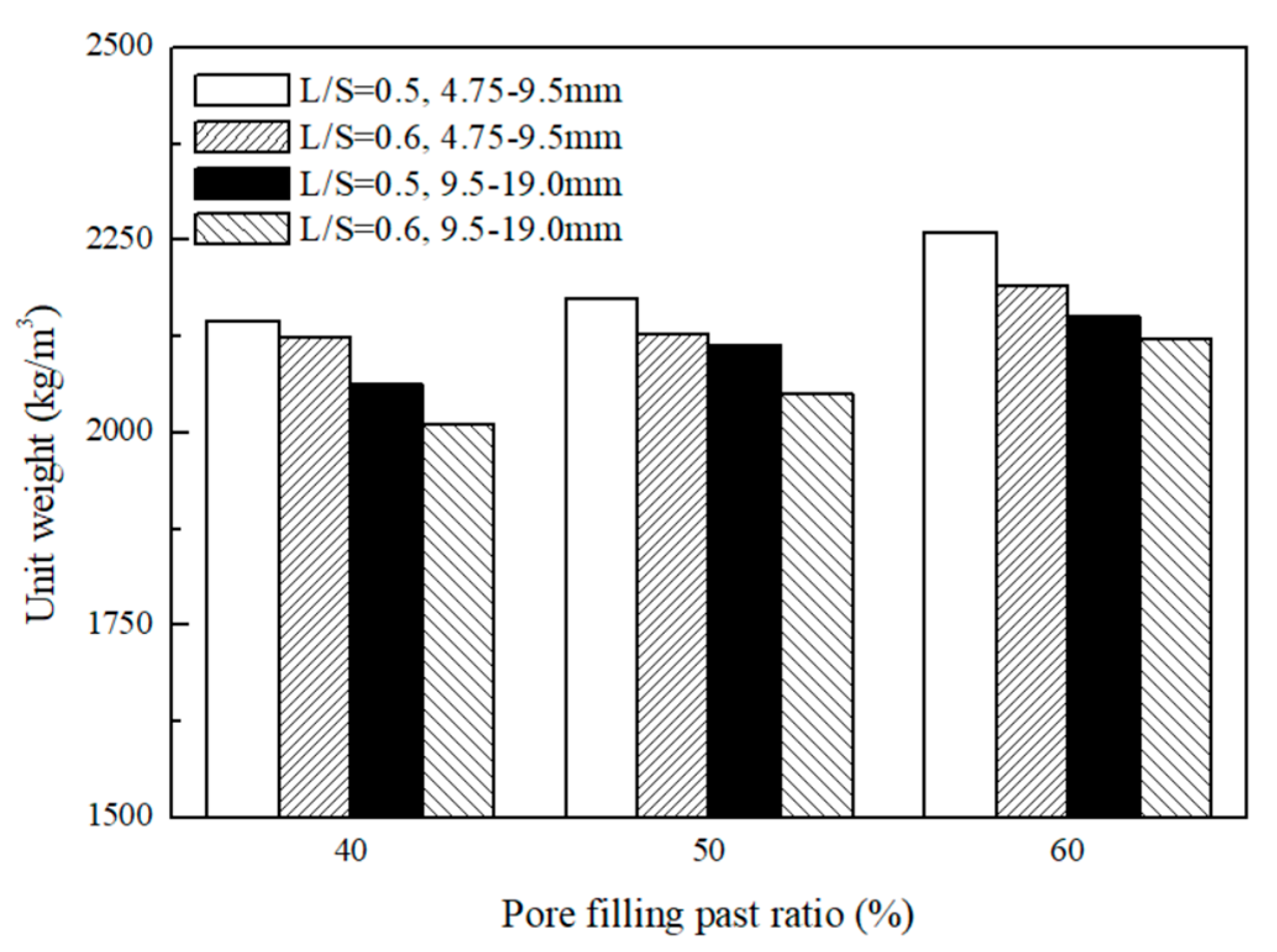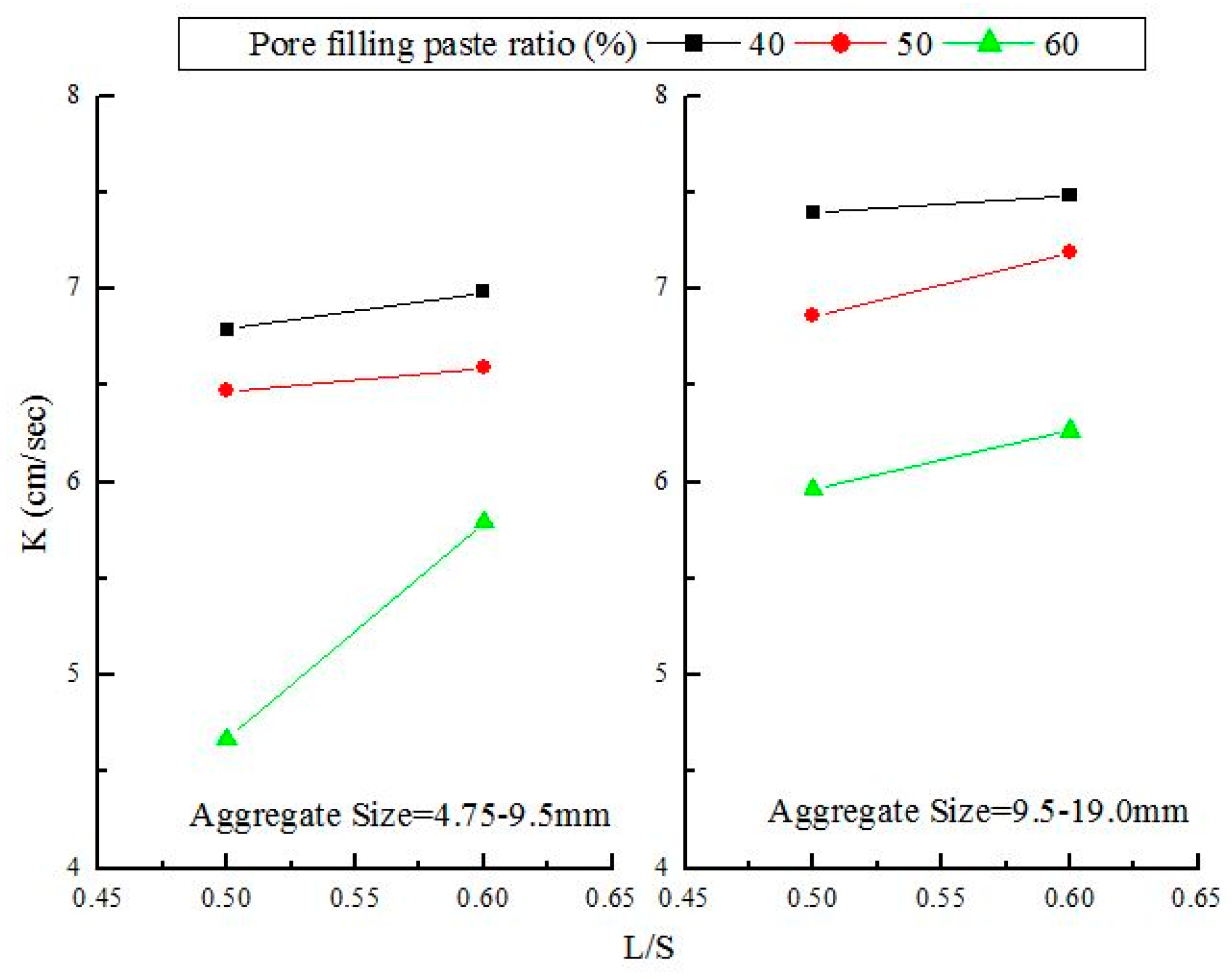Influence of BOF and GGBFS Based Alkali Activated Materials on the Properties of Porous Concrete
Abstract
1. Introduction
2. Testing Methods
2.1. Materials and Mix Proportions
2.2. Methods
3. Results and Discussion
3.1. Connected Porosity
3.2. Unit Weight
3.3. Permeability
3.4. Compressive Strength
3.5. Splitting Strength
3.6. Flexural Strength
3.7. British Pendulum Test
4. Conclusions
- The novel environmentally friendly GGBFS-based porous concrete had a connected porosity of 28.7%–34.3%, in which the connected porosity of GGBFS-based porous concrete with a particle size of 9.5–19.0 mm exceeded that of GGBFS-based porous concrete with a particle size of 4.75–9.5 mm. Compressive strength decreased and increased as the particle size and percentage of pore filling paste ratio increased and increased, respectively.
- The optimal component ratio was achieved when the pore filling paste ratio and aggregate particle size were 60% and 4.75–9.5 mm, respectively. It yielded a compressive strength and permeability of 8.31 MPa and 4.67 cm/s, respectively, in 28 days.
- The permeability coefficient and connected porosity of the novel, environmentally friendly GGBFS-based porous concrete decreased as the pore filling paste ratio increased. The permeability coefficient and connected porosity can be represented by the equation Y = 0.46534X – 8.09947.
- The compressive and splitting strengths of the novel environmentally friendly GGBFS-based porous concrete decreased as permeability increased. The use of porous concrete with a particle size of 4.75–9.5 mm increased mechanical strength but decreased permeability because the percentage of filling increased.
Author Contributions
Funding
Acknowledgments
Conflicts of Interest
References
- Kuo, W.T.; Liu, C.C.; Su, D.S. Use of washed municipal solid waste incinerator bottom ash in pervious concrete. Cem. Concr. Compos. 2013, 37, 328–335. [Google Scholar] [CrossRef]
- Japan Concrete Institute. Design, Construction. Recent Applications of Porous Concrete in Japan. In Proceedings of the JCI Symposium on Design, Construction, and Recent Applications of Porous Concrete, Tokyo, Japan, 10 June 2004. [Google Scholar]
- Putman, B.J.; Neptune, A.I. Comparison of test specimen preparation techniques for pervious concrete pavement. Constr. Build. Mater. 2011, 25, 3480–3485. [Google Scholar] [CrossRef]
- Shu, X.; Huang, B.; Wu, H.; Dong, Q.; Burdette, E.G. Performance comparison of laboratory and field produced pervious concrete mixtures. Constr. Build. Mater. 2011, 25, 3187–3192. [Google Scholar] [CrossRef]
- Sumanasooriya, M.S.; Neithalath, N. Pore structure features of pervious concretes proportioned for desired porosities and their performance prediction. Cem. Concr. Compos. 2011, 33, 778–787. [Google Scholar] [CrossRef]
- Crouch, L.K.; Pitt, J.; Hewitt, R. Aggregate effects on pervious Portland cement concrete static modulus of elasticity. Constr. Build. Mater. 2007, 19, 561–567. [Google Scholar] [CrossRef]
- Vancura, M.; Donald, K.M.; Khazanovich, L. Microscopic analysis of paste and aggregate distresses in pervious concrete in a wet, hard freeze climat. Cem. Concr. Compos. 2011, 33, 1080–1085. [Google Scholar] [CrossRef]
- ACI Committee 522. Pervious Concrete. Report No. 522R-10; American Concrete Institute: Detroit, MI, USA, 2010. [Google Scholar]
- Park, S.B.; Tia, M. An experimental study on the water-purification properties of porous concrete. Cem. Concr. Res. 2004, 34, 177–184. [Google Scholar] [CrossRef]
- Naganathan, S.; Razak, H.A.; Hamid, S.N.A. Properties of controlled low-strength material made using industrial waste incineration bottom ash and quarry dust. Mater. Des. 2012, 33, 56–63. [Google Scholar] [CrossRef]
- Wang, W.C.; Liu, C.C.; Lee, C.; Yu, S.K. Preliminary research of expansion problem and treated method of using slag as aggregate of concrete. In Proceedings of the TCI Conference on Concrete Engineering, Tainan, Taiwan, 18 November 2011. (In Chinese). [Google Scholar]
- Waligora, J.; Bulteel, D.; Degrugilliers, P.; Damidot, D.; Potdevin, J.L. Measson, M.; Chemical and mineralogical characterizations of LD converter steel slags: A multi-analytical techniques approach. Mater. Charact. 2010, 61, 39–48. [Google Scholar] [CrossRef]
- Shen, D.H.; Wu, C.M.; Du, J.C. Laboratory investigation of basic oxygen furnace slag for substitution of aggregate in porous asphalt mixture. Constr. Build. Mater. 2009, 23, 453–461. [Google Scholar] [CrossRef]
- Shen, W.; Zhou, M.; Ma, W. Investigation on the application steel slag-fly ash-phosphogypsum solidified material as road base material. Hazard. Mater. 2009, 164, 99–104. [Google Scholar] [CrossRef]
- Kuo, W.T.; Shu, C.Y. Application of high-temperature rapid catalytic technology to forecast the volumetric stability behavior of containing steel slag mixtures. Mater. Des. 2014, 64, 608–613. [Google Scholar] [CrossRef]
- Mohammad, M.; Ahmad, A.; Khaled, M.S.; Paivo, K.; Zahra, A.; Bethany, W.; Mirja, I. Using Carbonated BOF Slag Aggregates in Alkali-Activated Concretes. Materials 2019, 12, 1288. [Google Scholar]
- Palankar, N.; Shankar, A.R.; Mithun, B. Durability studies on eco-friendly concrete mixes incorporating steel slag as coarse aggregates. J. Clean. Prod. 2016, 129, 437–448. [Google Scholar] [CrossRef]
- Palankar, N.; Ravi Shankar, A.U.; Mithun, B.M. Investigations on Alkali-Activated Slag/Fly Ash Concrete with steel slag coarse aggregate for pavement structures. Int. J. Pavement Eng. 2017, 18, 500–512. [Google Scholar] [CrossRef]
- Bodor, M.; Santos, R.M.; Cristea, G.; Salman, M.; Cizer, Ö.; Iacobescu, R.I.; Chiang, Y.W.; Van Balen, K.; Vlad, M.; Van Gerven, T. Laboratory investigation of carbonated BOF slag used as partial replacement of natural aggregate in cement mortars. Cem. Concr. Compos. 2016, 65, 55–66. [Google Scholar] [CrossRef]
- Sarker, P.K. Bond strength of reinforcing steel embedded in fly ash-based geopolymer concrete. Mater. Struct. 2011, 44, 1021–1030. [Google Scholar] [CrossRef]
- Songpiriyakij, S.; Pulngern, T.; Pungpremtrakul, P.; Jaturapitakkul, C. Anchorage of steel bars in concrete by geopolymer paste. Mater. Des. 2011, 32, 3021–3028. [Google Scholar] [CrossRef]
- Zhao, R.; Sanjayan, J.G. Geopolymer and Portland cement concretes in simulated fire. Mag. Concr. Res. 2011, 63, 163–173. [Google Scholar] [CrossRef]
- Temuujin, J.; Minjigmaa, A.; Lee, M.; Chen, T.N.; van Riessen, A. Characteristic of class F fly ash geopolymer pastes immersed in acid and alkaline solutions. Cem. Concr. Compos. 2011, 33, 1086–1091. [Google Scholar] [CrossRef]
- Kunal, K.P.; Fernando, S.; Ancy, K.; Erez, N.A.; Daniela, S.M. Multi-scale modeling and experimental investigations of geopolymeric gels at elevated temperatures. Comput. Concr. 2013, 122, 164–177. [Google Scholar]
- Coppola, L.; Coffetti, D.; Crotti, E. Pre-packed alkali activated cement-free mortars for repair of existing masonry buildings and concrete structures. Constr. Build. Mater. 2018, 173, 111–117. [Google Scholar] [CrossRef]
- Coppola, L.; Coffetti, D.; Crotti, E.; Marini, A.; Passoni, C.; Pastore, T. Lightweight cement-free alkali-activated slag plaster for the structural retrofit and energy upgrading of poor quality masonry walls. Cem. Concr. Compos. 2019, 104, 103341. [Google Scholar] [CrossRef]
- Yeih, W.; Fu, T.C.; Chang, J.J.; Huang, R. Properties of pervious concrete made with air-cooling electric arc furnace slag as aggregates. Constr. Build. Mater. 2015, 93, 737–745. [Google Scholar] [CrossRef]
- Jang, J.G.; Ahn, Y.B.; Souri, H.; Lee, H.K. A novel eco-friendly porous concrete fabricated with coal ash and geopolymeric binder: Heavy metal leaching characteristics and compressive strength. Constr. Build. Mater. 2015, 79, 173–181. [Google Scholar] [CrossRef]
- Chang, J.J.; Yeih, W.; Chung, T.J.; Huang, R. Properties of pervious concrete made with electric arc furnace slag and alkali-activated slag cement. Constr. Build. Mater. 2016, 109, 34–40. [Google Scholar] [CrossRef]
- Tho-in, T.; Sata, V.; Chindaprasirt, P.; Jaturapitakkul, C. Pervious high-calcium fly ash geopolymer concrete. Constr. Build. Mater. 2012, 30, 366–371. [Google Scholar] [CrossRef]
- Zaetang, Y.; Wongsa, A.; Sata, V.; Chindaprasirt, P. Properties of pervious geopolymer concrete using recycled aggregates. Constr. Build. Mater. 2015, 96, 289–295. [Google Scholar] [CrossRef]
- ASTM C138/C138M. Standard Test Method for Density (Unit Weight), Yield, and Air Content (Gravimetric) of Concrete; ASTM International: West Conshohocken, PA, USA, 2014. [Google Scholar]
- ASTM C39/C39M. Standard Test Method Compressive Strength of Cylindrical Concrete Specimens; ASTM International: West Conshohocken, PA, USA, 2014. [Google Scholar]
- ASTM C496/C496M. Standard Test Method for Splitting Tensile Strength of Cylindrical Concrete Specimens; ASTM International: West Conshohocken, PA, USA, 2011. [Google Scholar]
- ASTM D790. Standard Test Methods for Flexural Properties of Unreinforced and Reinforced Plastics and Electrical Insulating Materials; ASTM International: West Conshohocken, PA, USA, 2010. [Google Scholar]
- ASTM E303. Standard Test Method for Measuring Surface Frictional Properties Using the British Pendulum Tester; ASTM International: West Conshohocken, PA, USA, 2013. [Google Scholar]
- Sata, V.; Wongsa, A.; Chindaprasirt, P. Use of coal ash as geopolymer binder and coarse aggregate in pervious concrete. Constr. Build. Mater. 2013, 42, 33–39. [Google Scholar] [CrossRef]
- ACI Committee 318. Building Code Requirements for Structural Concrete and Commentary; American Concrete Institute: Detroit, MI, USA, 1999. [Google Scholar]












| Properties | Grade (mm) | |
|---|---|---|
| 4.75–9.5 | 9.5–19.0 | |
| Specific gravity (oven dry) | 3.31 | 3.36 |
| Absorption (%) | 1.83 | 1.18 |
| Unit weight (kg/m3) | 1964 | 1991 |
| Void content (%) | 39.7 | 40.5 |
| Chemical Characteristics (%) | ||||||||
|---|---|---|---|---|---|---|---|---|
| Item | SiO2 | Al2O3 | FeO | CaO | MgO | P2O5 | MnO | CaO/SiO2 |
| BOF | 20.34 | 1.4 | 20.92 | 36.38 | 5.95 | 3.26 | 2.57 | 1.79 |
| Grade (mm) | L/S | Pore Filling Paste Ratio (%) | Mix Proportion(kg/m3) | |||
|---|---|---|---|---|---|---|
| BOF | GGBFS | NaOH | Na2SiO2 | |||
| 4.75–9.5 | 0.50 | 40 | 1964 | 134 | 20 | 47 |
| 50 | 1964 | 167 | 25 | 58 | ||
| 60 | 1964 | 201 | 30 | 70 | ||
| 0.60 | 40 | 1964 | 117 | 21 | 49 | |
| 50 | 1964 | 147 | 26 | 62 | ||
| 60 | 1964 | 176 | 32 | 74 | ||
| 9.5–19.0 | 0.50 | 40 | 1991 | 136 | 20 | 48 |
| 50 | 1991 | 170 | 26 | 60 | ||
| 60 | 1991 | 204 | 31 | 72 | ||
| 0.60 | 40 | 1991 | 120 | 22 | 50 | |
| 50 | 1991 | 150 | 27 | 63 | ||
| 60 | 1991 | 180 | 32 | 75 | ||
| Conditions | BPN |
|---|---|
| Curve road, roundabouts, inclined slope | 65 |
| Common highway with traffic flow greater than 2000 vehicles/day | 55 |
| Others | 45 |
| Grade (mm) | Error Sources | Sum of Square | Degree of Freedom | Sum of Mean Squares | F | Threshold |
|---|---|---|---|---|---|---|
| 4.75–9.5 | L/S | 0.10 | 1 | 0.10 | 12.03 | 18.51 |
| Pore filling paste ratio | 2.93 | 2 | 1.47 | 173.86 | 19 | |
| Random | 0.02 | 2 | 0.01 | - | - | |
| Sum | 3.05 | 5 | - | - | - | |
| 9.5–19.0 | L/S | 0.14 | 1 | 0.14 | 16.47 | 18.51 |
| Pore filling paste ratio | 4.61 | 2 | 2.31 | 264.51 | 19 | |
| Random | 0.02 | 2 | 0.01 | - | - | |
| Sum | 4.77 | 5 | - | - | - |
© 2019 by the authors. Licensee MDPI, Basel, Switzerland. This article is an open access article distributed under the terms and conditions of the Creative Commons Attribution (CC BY) license (http://creativecommons.org/licenses/by/4.0/).
Share and Cite
Kuo, W.-T.; Gao, Y.-S.; Juang, C.-U. Influence of BOF and GGBFS Based Alkali Activated Materials on the Properties of Porous Concrete. Materials 2019, 12, 2214. https://doi.org/10.3390/ma12142214
Kuo W-T, Gao Y-S, Juang C-U. Influence of BOF and GGBFS Based Alkali Activated Materials on the Properties of Porous Concrete. Materials. 2019; 12(14):2214. https://doi.org/10.3390/ma12142214
Chicago/Turabian StyleKuo, Wen-Ten, Yi-Syuan Gao, and Chuen-Ul Juang. 2019. "Influence of BOF and GGBFS Based Alkali Activated Materials on the Properties of Porous Concrete" Materials 12, no. 14: 2214. https://doi.org/10.3390/ma12142214
APA StyleKuo, W.-T., Gao, Y.-S., & Juang, C.-U. (2019). Influence of BOF and GGBFS Based Alkali Activated Materials on the Properties of Porous Concrete. Materials, 12(14), 2214. https://doi.org/10.3390/ma12142214





